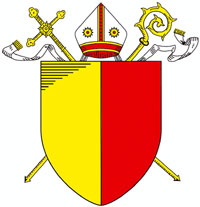
The archbishop of Cologne governs the Roman Catholic Archdiocese of Cologne in western North Rhine-Westphalia. Historically the archbishop was ex officio one of the prince-electors of the Holy Roman Empire and ruled the Electorate of Cologne.
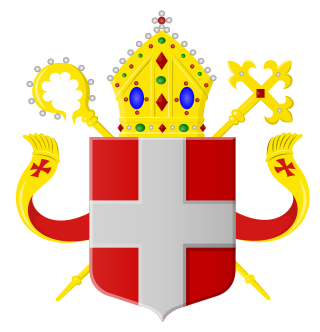
The Archdiocese of Utrecht is an archdiocese of the Latin Church of the Catholic Church in the Netherlands. The Archbishop of Utrecht is the metropolitan of the ecclesiastical province of Utrecht. There are six suffragan dioceses of the province: Roman Catholic Dioceses of Breda, of Groningen-Leeuwarden, of Haarlem-Amsterdam, of Roermond, of Rotterdam, and of 's-Hertogenbosch. The cathedral church of the archdiocese is Saint Catherine's Cathedral, which replaced the prior cathedral, Saint Martin's Cathedral after it was taken by Protestants in the Reformation.
A Diocesan Administrator is a provisional ordinary of a Catholic particular church.

The Diocese of Hildesheim is a Latin Church diocese of the Catholic Church in Germany. Founded in 815 as a missionary diocese by King Louis the Pious, his son Louis the German appointed the famous former archbishop of Rheims, Ebbo, as bishop.
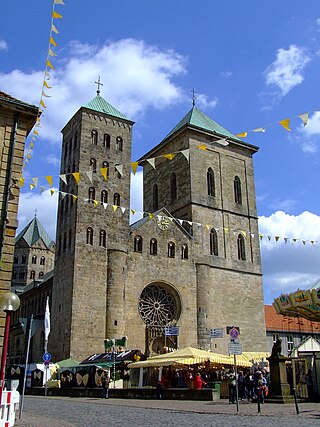
The Diocese of Osnabrück is a Latin Church ecclesiastical territory or diocese of the Catholic church in Germany. The diocese was originally founded circa 800. It should not be confused with the smaller Prince-Bishopric of Osnabrück–an ecclesiastical principality of the Holy Roman Empire until 1803–over which the bishop, as prince-bishop, exercised both temporal and spiritual authority.

The Diocese of Halberstadt was a Roman Catholic diocese from 804 until 1648. From 1180, the bishops or administrators of Halberstadt ruled a state within the Holy Roman Empire, the prince-bishopric of Halberstadt. The diocesan seat and secular capital was Halberstadt in present-day Saxony-Anhalt.

The Metropolitan Archdiocese of Paderborn is a Latin Church archdiocese of the Catholic Church in Germany; its seat is Paderborn. It was a diocese from its foundation in 799 until 1802, and again from 1821 until 1930. In 1930, it was promoted to an archdiocese. From 1281 until 1802, the Bishopric of Paderborn was also a state of the Holy Roman Empire.
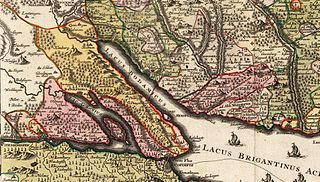
The Prince-Bishopric of Constance was a small ecclesiastical principality of the Holy Roman Empire from the mid-12th century until its secularisation in 1802–1803. In his dual capacity as prince and as bishop, the prince-bishop also administered the Diocese of Konstanz, which existed from about 585 until its dissolution in 1821, and whose territory extended over an area much larger than the principality. It belonged to the ecclesiastical province of Mainz since 780/782.

The Prince-Bishopric of Minden was an ecclesiastical principality of the Holy Roman Empire. It was progressively secularized following the Protestant Reformation when it came under the rule of Protestant rulers, and by the Peace of Westphalia of 1648 given to Brandenburg as the Principality of Minden. It must not be confused with the Roman Catholic diocese of Minden, which was larger, and over which the prince-bishop exercised spiritual authority.
Bishops of Vilnius diocese from 1388 and archdiocese from 1925:

The Prince-Bishopric of Bamberg was an ecclesiastical State of the Holy Roman Empire. It goes back to the Roman Catholic Diocese of Bamberg established at the 1007 synod in Frankfurt, at the behest of King Henry II to further expand the spread of Christianity in the Franconian lands. The bishops obtained the status of Imperial immediacy about 1245 and ruled their estates as Prince-bishops until they were subsumed to the Electorate of Bavaria in the course of the German Mediatisation in 1802.

The Diocese of Münster is a Latin Church ecclesiastical territory or diocese of the Catholic Church in Germany. It is a suffragan diocese of the Archdiocese of Cologne. Bishop Felix Genn is the current bishop of the Diocese of Münster. He was ordained to the priesthood on 11 July 1976 and was appointed to the See of Münster on 19 December 2008.

The Prince-Bishopric of Hildesheim was an ecclesiastical principality of the Holy Roman Empire from the Middle Ages until its dissolution in 1803. The Prince-Bishopric must not be confused with the Diocese of Hildesheim, which was larger and over which the prince-bishop exercised only the spiritual authority of an ordinary bishop.
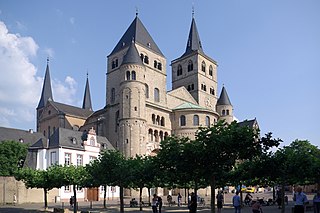
The Diocese of Trier, in English historically also known as Treves from French Trèves, is a Latin Church ecclesiastical territory or diocese of the Catholic church in Germany. When it was the archbishopric and Electorate of Trier, it was one of the most important states of the Holy Roman Empire, both as an ecclesiastical principality and as a diocese of the church. Unlike the other Rhenish dioceses—including Mainz and Cologne–Trier was the former Roman provincial capital of Augusta Treverorum. Given its status, Trier has continuously been an episcopal see since Roman times and is one of the oldest dioceses in all of Germany. The diocese was elevated to an archdiocese in the time of Charlemagne and was the metropolitan for the dioceses of Metz, Toul, and Verdun. After the victory of Napoleon Bonaparte of France, the archdiocese was lowered to a diocese and is now a suffragan in the ecclesiastical province of the Archdiocese of Cologne. The diocesan cathedral is the Cathedral of Saint Peter. The Cathedral Chapter retains the right to elect the bishop, rather than selection by papal appointment.

Conrad II of Reifenberg was Bishop of Hildesheim from 1221 to 1246. During his tenure, the Bishopric of Hildesheim was raised to an Imperial State (Hochstift), when Conrad was vested with secular rights of a prince-bishop by Emperor Frederick II in 1235.

In the Holy Roman Empire, the German term Hochstift referred to the territory ruled by a bishop as a prince, as opposed to his diocese, generally much larger and over which he exercised only spiritual authority. The terms prince-bishopric and ecclesiastical principality are synonymous with Hochstift. Erzstift and Kurerzstift referred respectively to the territory (prince-archbishopric) ruled by a prince-archbishop and an elector-archbishop while Stift referred to the territory ruled by an imperial abbot or abbess, or a princely abbot or abbess. Stift was also often used to refer to any type of ecclesiastical principality.

The Diocese and Prince-bishopric of Schwerin was a Catholic diocese in Schwerin, Mecklenburg, in Germany. The first registered bishop was ordained in the diocese in 1053, and the diocese ceased to exist in 1994.
